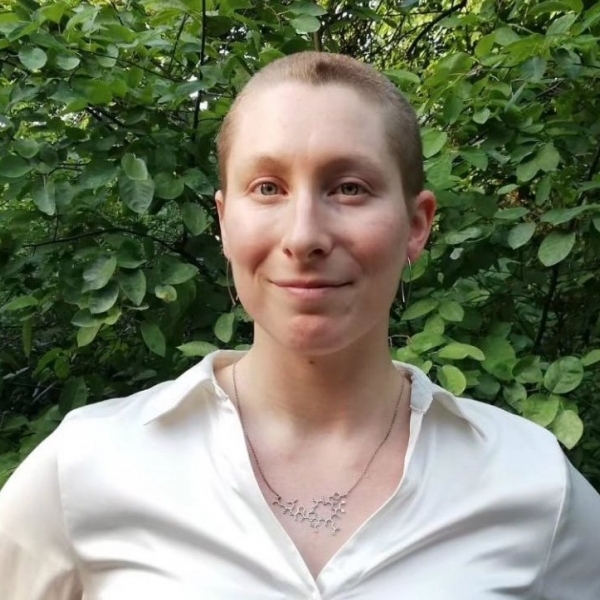Sztain Deploys Computational Methods to Advance Drug Discovery, Protein Engineering
September 25, 2024
By: Toni Shears
 Our bodies are a swirling, dynamic universe of biochemical reactions, with billions of tiny molecules catalyzing or binding to others in constant biochemical reactions.
Our bodies are a swirling, dynamic universe of biochemical reactions, with billions of tiny molecules catalyzing or binding to others in constant biochemical reactions.
Terra Sztain, who joined the College of Pharmacy in September 2023 as an Assistant Professor of Medicinal Chemistry. uses powerful computer simulations — accelerated with machine learning and artificial intelligence techniques — as a “computational microscope” to peer into these complex molecular processes. Blending approaches from chemistry and biophysics with mathematical models and computer science, she can reveal the dynamics of biochemical systems and predict how these dynamics might change in different circumstances.
This opens new frontiers for designing new drugs, engineering proteins or predicting and preventing mutations that allow viruses to escape treatment.
With this cutting-edge modeling, “We’re trying to understand the movements and pathways that are involved in biochemical reactions, and how we can use that to modulate those functions,” says Sztain.
Modeling Viral Mutations and Resistance for COVID-19
As an example, she notes, “With molecular dynamics simulations we are able to visualize how the SARS-CoV-2 spike protein opens and infects humans.” Her research team identified a glycan, or sugar molecule, within the virus that pushes open the receptor binding domain so it can bind to ACE2 receptors on human cells. This offers new potential for disabling the SARS-CoV-2 virus and treating COVID-19.
Additionally, her lab team is using machine learning methods to predict variants in the SARS-CoV-2 virus. “As we have experienced through the pandemic, the possibilities for mutations are huge – basically the length of a protein to the power of 20,” she says. Using a deep mutational scanning database with hundreds of thousands of mutations, they can analyze how mutations in an amino acid affect the strength of protein binding.
“With our methods, we can use neural networks to learn the patterns of mutations and can predict how the virus will mutate. We were able to confirm that the virus did evolve in the directions that our models predicted,” she says.
Through computer simulations of the evolutionary patterns in the receptor that binds to and infects human cells, Sztain has discovered simulated variants that bind better than those circulating through the population. Learning how these variants bind to healthy cells offers the potential to disrupt the infection and will guide efforts to design a universal treatment that will be effective across evolving variants.
Understanding how a virus will mutate is an important step in dealing with drug resistance, Sztain says. “Mutations change the protein structures, so they are less treatable. If we know how they are changing, we can shift the design of treatments. We’re also looking at how we can prevent the drug-resistant mutations and design the next generation of inhibitors.”
Computer-Guided Drug Discovery
Her multidisciplinary methods are providing a foundation for drug discovery beyond COVID. In another project, Sztain’s team is using machine learning to analyze DNA-encoded library screens. In these libraries, a DNA molecule is attached to a chemical compound to act as a “barcode” enabling screening of millions of molecules simultaneously. Her group is working with Michigan Drug Discovery and Center for Chemical Genomics to develop machine learning methods for expanding the information obtained from high throughput screening experiments.
“We’re using machine learning to analyze and extrapolate from that data to find chemical molecules that bind to our protein of interest,” Sztain says. “This is a way to screen really large chemical libraries against a target. From there, we can create molecular and dynamic simulations of the proteins to understand the movements and pathways that are involved in systems.”
“Then we can study how we can use that information to engineer compounds that will modulate those functions. The chemical world is so vast; how do you even know where to start to find one that will affect your target cells? This kind of modeling gives some sort of direction to the drug discovery process,” she explains. “The goal is to develop computer-guided methods that would normally take years to simulate and reduce this to an order of months.”
The cutting-edge research Sztain is pursuing is one more example of what makes the college a center for enterprising research. Work like hers advances the goal of managing and eliminating infectious diseases while making a positive impact on humankind.
Most Recent Stories
PharmD Alum Goes Beyond the Beaten Path to Build a Successful Career
April 22, 2025
Dr. Kristen will bring her “Go Blue” spirit to the stage of PharmD Commencement as the keynote speaker – something she considers a great honor.
Leaning into Leadership: An Alum’s Journey to Pharmacy Administration
April 15, 2025
When it comes to pharmacy, Michelle Azar, PharmD ’21, is sure about one thing: Your path can change, and there are limitless avenues you can take with a PharmD.
Building Specialized Pharmacy Services from the Ground Up
March 28, 2025
“I never dreaded getting up and going to work. I loved what I did. When things changed, I looked at it as an opportunity or a challenge.”